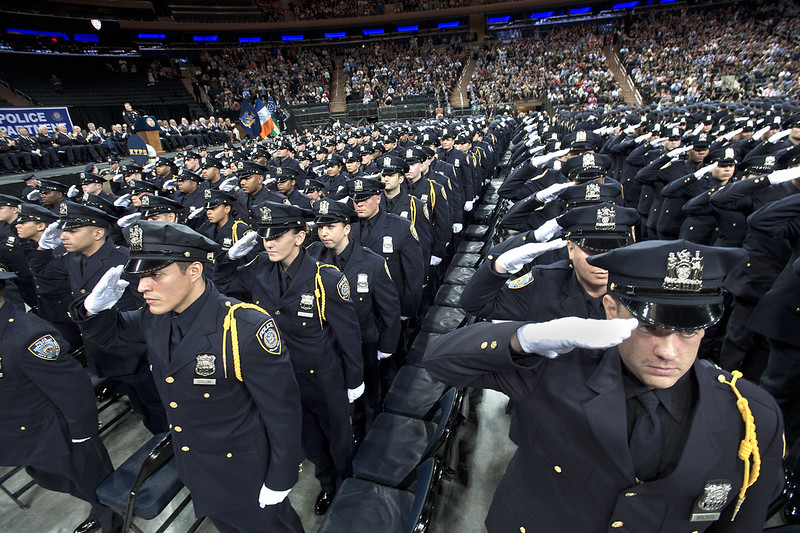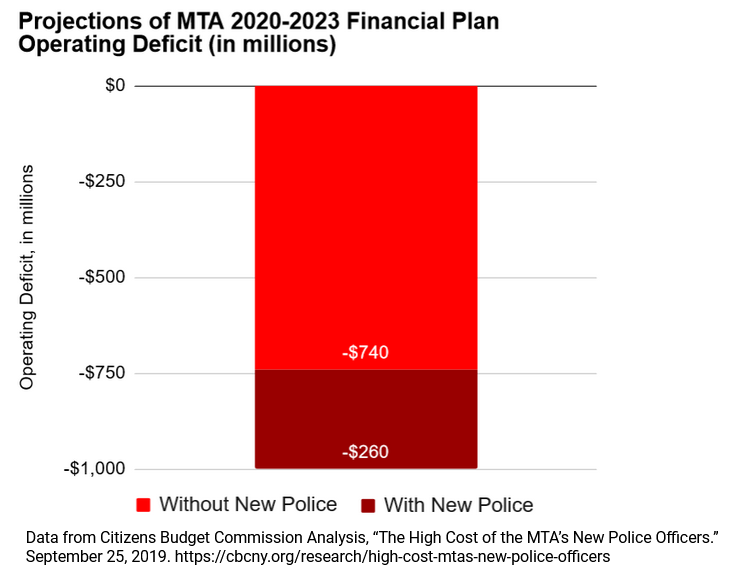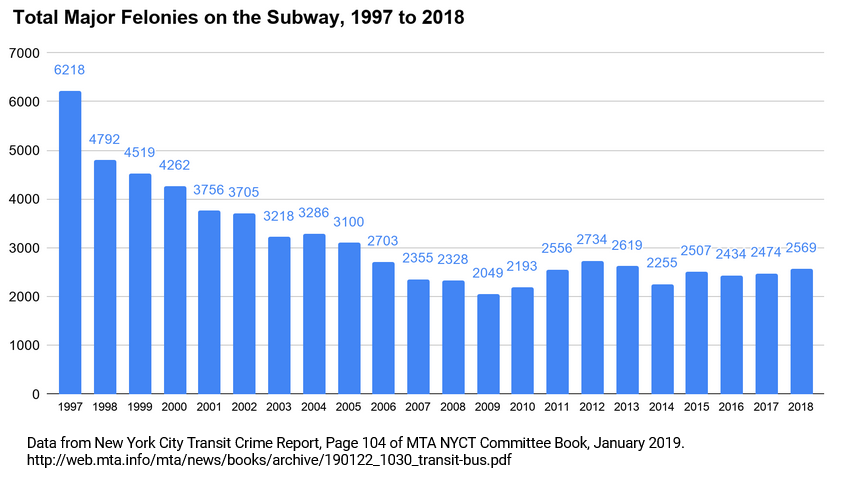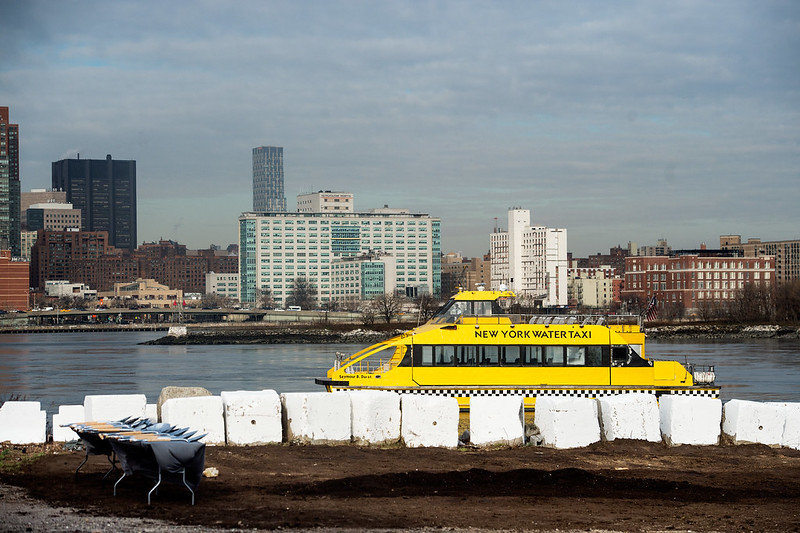Facts Don't Support Expanding the Size of the MTA Police Force

(photo: Metropolitan Transportation Authority/Patrick Cashin)
MTA Chair and CEO Pat Foye says the transit authority’s operating budget is in “dire” condition and independent budget watchdogs are alarmed its deficit is growing to unmanageable levels. Citizens Budget Commission estimates the MTA will be $740 million in the red in 2023 -- and this does not include new debt payments for the new, massive $51.5+ billion 2020-2024 capital plan. Separately, NYPD data shows subway crime is down 3% from last year, and Police Commissioner James O’Neill says the subway, which carries 6 million passengers a day, averages only six major crimes a day.
Given the gaping budget hole -- which recently led to cuts in bus service on the B46 -- and the low crime rate, we wonder how the MTA justifies a costly increase in the size of its police force by 581 more officers and supervisors as first uncovered by Gothamist to address “quality of life issues.” This larger MTA force will cost the authority an additional $260 million more in operating costs over the next four years, as calculated by Citizens Budget Commission, and will force cuts elsewhere in the operating budget -- including, logically, in transit service.
The MTA should make a decision of this magnitude based on a transparent, data-driven analysis that shows why expanding the MTA police force is more worthwhile than expanding transit service -- or even preserving existing service. The MTA should explain to the transit riding public what an expanded MTA police force can do that the current 2,500 NYPD officers and approximately 300 redeployed MTA police officers patrolling the subways and buses are not doing.
Disappointingly, the decision to increase the MTA police -- which is widely believed to be at Governor Cuomo’s behest -- has been made in a fact-free zone. The reasoning used has also shifted from fare evasion to homelessness to worker and rider safety, or a combination of all of the above. The public discussions by some MTA Board members has consisted of anecdotes and unfounded assumptions on these issues, and MTA staff have not provided analyses that examine alternatives or even dig deeply into existing MTA data.
(Note to MTA Board: MTA police officers guarding a turnstile only pay for themselves if fare revenue at that station goes up by at least the cost of the officers stationed there. Can we see some actual data that supports the argument that spending $260 million over the next four years on more MTA police will increase fare revenue by that much? What about the four years after that, etc.?)
If one of the governor’s stated goals is to reduce the number of homeless people in the subways, let’s see some evidence that an expensive increase in the size of the MTA police force will or even can do that, or that spending large sums on more police is even the best way to do that. Again, where is the data showing a relationship between the number of police officers and homelessness in the subways?
What we are seeing with the MTA policing issue is the latest example of a once-respected public authority that has been politicized and compelled to spend huge amounts on political grandstanding rather than objective priorities. Just last month, the MTA’s $51.5+ billion capital plan was approved by its Board before it published a needs assessment that establishes detailed baseline costs for getting the system to a state of good repair.
Governor Cuomo has publicly called on the MTA to be more professional and efficient. We agree, but competent, professional management is fact- and data-driven, and does not make decisions based on the politics of the moment. The data here does not support almost doubling the size of the MTA police force from 783 to 1,364 -- especially given the “dire” budget.
Professional, fact-based thinking by the MTA Board and management would mean rejecting this unnecessary expenditure and recognizing there is a direct trade-off between more police and more transit service.
How Much Money Are We Talking Here?
According to Citizens Budget Commission, increasing the size of the MTA police force with 500 new officers and 81 supervisors for the new hires will cost $56.1 million in year one and $119.9 million in year ten. Over the 2020-2023 financial plan, the new officers will cost $260 million and push the MTA’s projected operating budget deficit of $740 million to $1 billion.

Reinvent Albany and other watchdog groups including Citizens Budget Commission, NYPIRG Straphangers Campaign, TransitCenter, and the Tri-State Transportation Campaign sent a letter to the MTA Board calling on the MTA to identify exactly how it will fund nearly doubling the size of the MTA police force without increasing its growing operating deficit. The groups specifically expressed the concern that an expanded MTA police force will reduce the MTA’s ability to maintain a high level of transit service -- its core responsibility.
The MTA still hasn’t said how it will pay for these officers, and what the true cost will be in terms of reductions in staff and service. Its next budget presentation is due at its November 14 Board meeting, and this is likely to be the first time this new expense shows up in its budget. The MTA Board will then approve a final budget at its December meeting, so it is not too late to reverse course.
The MTA’s Many Justifications for Increasing its Police Force
There are many opinions about having more police in the subways and buses. Some oppose over-policing and some are concerned about service cuts, while others believe more police will increase customer and operator safety.
For Reinvent Albany, what cuts across all of these issues is the consistent failure of the MTA -- or Governor Cuomo -- to make credible, fact-based decisions regarding major spending. The governor and the MTA have access to professional analysts, detailed data about operations and crime, and outside experts who could guide their decisions. Instead, this decision has been made without meaningfully using any of them.
We at Reinvent Albany are not criminologists or experts in homelessness or fare evasion. But we do believe in and know the value of data and rational decision-making. Given that the MTA hasn’t been allowed to do its homework, we are providing just some of the data and options that need to be examined before any decisions are made.
Crime
Crime on the subways is a clear area where perception and reality aren’t matching up. Governor Cuomo was recently blasted by the NYPD’s own leader for saying that crime in the subways is on the rise, with Commissioner O’Neill noting that the opposite is true. O’Neill instead said there has been a decrease in crime and “I absolutely disagree with Governor Cuomo’s characterization.” According to the latest stats from New York City Transit, total major felonies are down this year versus last (January-September) -- with 1,774 major felonies in 2019 and 1,799 in 2018.
Major crimes have dropped significantly since 1997, when there were 6,218 major felonies in the subways and buses. For the last four years, major felonies have numbered about 2,500 per year. It is worth noting the decrease happened during a period of increasing ridership: since 1997, annual ridership increased from 1.1 billion to nearly 1.7 billion.

Perception often colors riders’ feelings about crime rather than actual data, as noted in a New York Times piece from earlier this year on subway crime. Social media, for example, is one big driver of perceptions. In speaking with the Times, NYPD Transit Chief Edward Delatorre said that the number of crimes in the subway is so small that “one or two recidivist offenders can enter the system and throw the crime numbers out of whack.” (For scale, there were 95,883 major felonies committed in New York City as a whole in 2018, down from 184,652 in 2000.)
Where particular types of crime have increased yet overall major crimes are flat or decreasing, refocusing existing officers is a more reasonable approach than hiring hundreds of new ones. Two areas that have received considerable attention are hate crimes, which increased from 37 to 65 from 2018 to 2019 (January-September), and assaults against subway workers, which according to the transit workers union (TWU) increased from 61 to 85 when comparing the first eight months of 2018 to 2019.
Homelessness
The MTA recently released a 9-page “report” of recommendations from its Homelessness Task Force. To be clear, this is not a “report,” as there is no credible analysis: it is essentially a directive from the governor to the MTA. The "report," which came after repeated complaints by the Governor about homelessness on the subways, found a 20% increase in homelessness in the subways from 2018 to 2019. The total increase found from a January 2019 survey was from 1,771 to 2,178, an increase of 407 people. This single data point was then used as the sole justification for a directive by the task force to increase the MTA police force by 50%.
Despite the report saying that the task force was “charged with delivering a set of recommendations to the MTA Board of Directors for actions to address the growing number of homeless individuals,” the report says that the MTA will increase its police force.
The MTA Board has not yet approved a budget for these new officers. At the direction of the governor, MTA staff is moving forward with these hires, undermining the fiduciary responsibility of the Board, who must consider how the MTA can best serve riders with its scarce resources.
Fare Evasion
Fare evasion has become a fixation for the governor and some of his appointees to the MTA Board, with more and more demands being placed on MTA staff to address the issue. According to the MTA’s June 2019 data, it lost $240 million to fare evasion over 12 months. But while the MTA has said fare evasion is growing, its Inspector General, who is appointed by the governor, in an audit said the MTA’s fare evasion stats are not credible.
At the same time, the MTA has ramped up enforcement efforts with redeployed police, new signage, and more cameras. If you believe the data, this may not be working. The MTA IG’s audit said that the “impact of these initiatives would be difficult to assess without reliable data on evasion levels and trends.”
The MTA can’t make rational decisions on fare evasion unless it better understands the problem first, and can trust its own data. And before jumping to any solutions, it would be worth assessing any number of other options to get more riders to pay the fare.
Rather than punitive approaches, options include providing better service so riders feel like they are getting what they pay for. The MTA and New York City could enroll more people in the Fair Fares program, which provides low-income riders a 50% fare discount. A Wall Street Journal report found an approach from behavioral psychology of praising paying customers decreased evasion in other systems.
The MTA could also examine further expanding station infrastructure like cameras and more signage to deter the use of emergency gates. (This was the original stated purpose of $40 million in funds coming from the Manhattan District Attorney, which the MTA has erroneously claimed will largely cover the cost of new officers.)
Yet another option is deployment of more cost-effective civilian staff. The MTA has said that more orange-vested staff could provide a deterrent to fare evasion, while providing more customer service. Additionally, the MTA’s Select Bus Service enforces fare payment with its Eagle Teams, who are not police officers. Unlike on other buses and the subway, Select Bus riders do not have to dip their Metrocards on the bus to pay the fare, but instead pay in advance and must show proof of payment upon request of the Eagle Teams. Ironically, the MTA’s Eagle Teams saw 22 staff members cut in the MTA’s 2018 budget reduction program, which in retrospect seems highly questionable as the MTA has said they do indeed pay for themselves.
The MTA Board Must Reject this Proposal
Before spending scarce transit operating dollars that almost doubles the size of the MTA police force, the MTA should work with its own officers and those from the NYPD to establish clear goals and expectations and improve the effectiveness of existing policing. The MTA Board needs to hear fact-based arguments with cost/benefit analyses of the various options to address safety, homelessness, and fare evasion. The MTA Board should reject hiring more police officers until its members and the public have real information about the opportunity costs of this proposal.
***
Rachael Fauss is senior research analyst for Reinvent Albany. On Twitter @RachaelFauss & @ReinventAlbany.
***
Have an op-ed idea or submission for Gotham Gazette? Email This email address is being protected from spambots. You need JavaScript enabled to view it.
Letter to the Editor: A Broken Toy Argument

(photo: Design_Miss_C via pixabay.com)
To the Editor:
As co-leaders of New York’s JustGreen Partnership, a coalition of over 50 broad, diverse organizations representing over one million New Yorkers, we’ve led the charge for environmental health and justice for New York’s people and communities. Securing the same protections for New York’s children that other states like Washington and Vermont require has been a top priority of this coalition. That’s why Governor Cuomo, a national leader on children’s health, should further demonstrate his long-standing prioritization of these issues by signing the Child Safe Products Act.
We’d like to set the record straight regarding the threadbare, timeworn mistruths in Matthew Lenz’s opinion piece, “Toy Companies in New York and Across America Put Child Safety First,” (Oct. 23, 2019), which was itself a response to a column by Christine Appah of New York Lawyers for the Public Interest asking the governor to sign this important legislation.
Lenz states that “U.S. toy safety requirements are among the strictest in the world,” and cites extremely limited and widely unenforced laws. He states, “these regulations make it illegal to sell toys or children’s products containing substances harmful to children and to which they might be exposed.” What Lenz doesn’t say is those standards allow toy manufacturers to put formaldehyde in doll clothing, organohalogens in toddler furniture, PFAS chemicals in changing pads, and much more.
Likewise, Lenz also fails to disclose that Toy Association members, including toy manufacturers in New York, submit to Washington State thousands of reports of the presence of nearly a hundred chemicals hazardous to children. How can both things be true? They can’t.
Clean and Healthy New York, WE ACT for Environmental Justice, and our allies purchased toys around the state and Clean and Healthy New York screened them using x-ray fluorescence technology. The results prove Appah was accurate when saying “there are many toys and products on the market today that do indeed contain chemicals that are hazardous to children’s health.”
Lenz further touts a failed, old-school, risk-based approach to regulating chemicals in children’s products. This approach concerns itself with how much of a chemical produces a specific health outcome and grounds that determination on a protocol that uses a healthy, 30-year-old white male as the reference model. This scheme is not based on the unique vulnerabilities of the child, does not fully factor in all of the exposure pathways to a chemical, and does not consider other factors affecting disease, such as race, heredity, diet, and stress. In short, it is set up to allow the continued presence of toxic chemicals in children’s products.
Despite observable proof that there are no empty store shelves in states with common-sense measures to disclose and limit toxic chemicals, Lenz attempts to scaremonger with this claim. Not a single job has been lost due to more protective chemical regulation. In fact, there is a strong business case for disclosure of toxic hazards, and restrictions when appropriate.
Certain companies, such as New York-based Community Playthings, commit to selling only toys and other childcare items without any toxicants disclosed to Washington State. New York’s law, when signed by Governor Cuomo, will not only provide parents with the right to know about the presence of more toxicants than any other state, but will place long-overdue restrictions on some of the worst, such as asbestos, formaldehyde, and organohalogens. Toymakers will no doubt comply, as they do elsewhere. Together we can build a toxic-free future for our most precious resource: the next generation.
Sincerely,
by Kathleen A. Curtis & Cecil Corbin-Mark
Curtis, LPN, is Executive Director of Clean and Healthy New York. Corbin-Mark is Deputy Director of WE ACT for Environmental Justice.
***
Have an op-ed idea or submission for Gotham Gazette? Email This email address is being protected from spambots. You need JavaScript enabled to view it.
Missing from the 2019 Ballot, We Can't Wait to Take on Better City Planning

(photo: Demetrius Freeman/Mayoral Photography Office)
New Yorkers heading to the polls this fall have the opportunity to vote on amendments to New York City’s Charter – our city’s foundational governing document – that include changes to how we vote, police accountability, and budgeting. But one big topic will be missing: truly addressing our city’s broken land use system.
This didn’t have to be the case. When the City Council, then-Public Advocate Letitia James, and Manhattan Borough President Gale Brewer came together to create this Charter Revision Commission in spring of 2018 there were high hopes for what it might accomplish. Unlike previous commissions charged with a narrow focus, Commission Chair Gail Benjamin announced, “This is a commission that received a broad mandate to overhaul the charter, which has not been done since 1989.” Instead of looking small, this commission would be going big.
Given the land use expertise of many of the appointed commissioners, including Chair Benjamin - and the expressed hopes of the elected officials who helped create the commission - advocates, New York City residents, and our elected representatives believed this broad mandate included the way our land use planning is done. During public hearings in all five boroughs, the commission heard more complaints about our broken land use process than any other issue.
The Thriving Communities Coalition formed in response to what we believed was a once-in-a-generation opportunity to overhaul our land use process, provide more access and accountability to average New Yorkers and address the needs of low-income communities and communities of color by working to end, rather than perpetuate, the legacy of historically racist planning.
As a coalition of grassroots organizing, advocacy, policy, and technical-assistance groups working across issue areas and neighborhoods, we knew first-hand the ways in which the planning process isn’t working: from the affordable housing and homelessness crisis - fueled in part by the rampant gentrification and displacement of formerly affordable communities - to the income and race inequalities that make us one of the most segregated and unequal cities in the country.
Throughout the charter reform process, the Thriving Communities Coalition fought for the commission to take up a comprehensive planning process that accounts for historical divestments from communities of color and a budget that equitably distributes resources - sharing our perspectives on the urgent need for real reform to empower disenfranchised communities and fight deeply entrenched racial and socio-economic inequality.
And yet in the end, the commission chose not to advance any meaningful land use reforms. Faced with the opportunity to make historic changes after hearing from a groundswell of folks about the urgent need, and after acknowledging in its preliminary report the “level of public disillusionment” with regards to land use and planning processes, the commission chose to settle, offering “tweaks” to the charter and rejecting calls for more transformational change.
Instead of comprehensive planning and the equitable distribution of resources, we have been offered an extended review period for Community Boards over the summer, and development plans being made public 30 days before the official public review starts. Instead of looking big, this commission went small.
We cannot wait another 30 years for a Charter Revision Commission that embraces its broad mandate to come along. Continuing the current land use process is unacceptable and unsustainable. While the status quo might work for developers and the powerful few, it does not work for most New Yorkers. Without meaningful changes, the processes we have now will only exacerbate inequality, segregation, and displacement. We will need more vision from our elected officials and leaders if we are to become a city where everyone has a chance to grow and thrive.
***
Chris Walters is the Rezoning Technical Assistance Coordinator at the Association for Neighborhood and Housing Development and a member of the Thriving Communities Coalition – a coalition of community-based and policy-oriented nonprofits focused on equitable land use and planning processes. On Twitter @ANHDNYC.
***
Have an op-ed idea or submission for Gotham Gazette? Email This email address is being protected from spambots. You need JavaScript enabled to view it.




